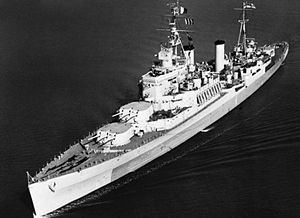 Uganda underway
| |
| History | |
|---|---|
| Name | Uganda |
| Ordered | 1939 |
| Builder | Vickers-Armstrong, Newcastle upon Tyne |
| Laid down | 20 July 1939 |
| Launched | 7 August 1941 |
| Commissioned | 3 January 1943 |
| Identification | Pennant number: 66 |
| Honours and awards | Atlantic 1943, Sicily 1943, Salerno 1943, Mediterranean 1943[1] |
| Fate | Transferred to Royal Canadian Navy on 21 October 1944 |
| Name | Uganda |
| Acquired | 21 October 1944 |
| Commissioned | 21 October 1944 |
| Honours and awards | Okinawa 1945 |
| Renamed | HMCS Quebec 14 January 1952 |
| Namesake | Province of Quebec |
| Recommissioned | 14 January 1952 |
| Decommissioned | 15 June 1956 |
| Identification | Pennant number: C66 |
| Motto | Nos canons parleront (Our cannons shall speak)[2] |
| Fate | Arrived at Osaka, Japan, on 6 February 1961 for scrapping |
| Badge | Or, a maple leaf vert charged with a fleur-de-lis of the first[2] |
| General characteristics | |
| Class and type | Fiji-class light cruiser |
| Displacement |
|
| Length | 169.3 m (555 ft 5 in) |
| Beam | 18.9 m (62 ft 0 in) |
| Draught | 5.3 m (17 ft 5 in) |
| Propulsion |
|
| Speed | 33 kn (61 km/h; 38 mph) |
| Range | 10,200 nmi (18,900 km; 11,700 mi) at 12 kn (22 km/h; 14 mph) |
| Complement |
|
| Sensors and processing systems |
|
| Armament |
|
| Armour | |
| Aircraft carried | Two Supermarine Walrus aircraft, removed November 1943. |
HMS Uganda was a Second World War-era Fiji-class light cruiser launched in 1941. She served in the Royal Navy during 1943 and 1944, including operations in the Mediterranean, and was transferred to the Royal Canadian Navy as HMCS Uganda in October 1944. She served in the Pacific theatre in 1945 and was put into reserve in 1947. When she was reactivated for the Korean War in 1952 she was renamed HMCS Quebec. She was decommissioned for the last time in 1956 and scrapped in Japan in 1961.
- ^ Britain's Navy
- ^ a b Arbuckle, p. 97